Journal of Nutrition & Food Sciences
Open Access
ISSN: 2155-9600
ISSN: 2155-9600
Research Article - (2023)Volume 13, Issue 3
Triticum aestivum (common wheat) is one of the most cultivated and consumed crops in many parts of the world. It contains carbohydrates, protein, fat, is rich in vitamins (thiamine and vitamin-B), minerals (zinc, iron), and rich source of fiber and antioxidants as well. Wheat is widely used for making wheat flour, bread, chapatti, refined forms of it, dalia, and many more. Wheatgrass is considered one of the richest sources of antioxidants. This study aims to analyze and compare the variation in antioxidant and anti-microbial properties in different processed stages of Triticum aestivum. The various samples were extracted in different solvents and further estimated for antioxidant and antimicrobial activity. The antioxidants were estimated by determining the total phenolics, total flavonoids, and DPPH of the samples. The results showed that there was a substantial reduction in the antioxidant property of bread and chapatti samples as compared to wheat flour extracts. The antimicrobial activity was determined by plating bacterial and fungal strains and applying different extracts to calculate the zone of inhibition. Antioxidants help our body to neutralize oxides present or produce within the body because of various metabolic activities. The presence of antioxidants also increases the life span of the food item. The significant effect on the antioxidant and antimicrobial property due to procedures like heating, grinding, and baking which is being implied to change the form of wheat to convert it into another product impacts its properties inside as well as outside.
Antioxidants; Refined forms; Phytochemical; Phenolics; Flavonoid
Metabolic activities in the body produce lots of oxides or free radicals and they are very reactive in nature hence can damage cellular components and cause various life-threatening diseases. Antioxidants help in neutralizing these free radicals [1].
A perfect balance between antioxidant and free radical improves a person’s health and saves him/her from diseases such as diabetes, thyroid, and many skin diseases [2].
Phenolic compounds are said to be the most important healthpromoting phytochemicals found in wheat grains as per many scientific types of research, as they possess strong antioxidant properties [3].
Among health-promoting phytochemicals residing in whole grains of wheat, phenolic compounds have gained much attention in many scientific research areas, as they have strong antioxidant properties. Phenolic acids and flavonoids represent the most common form of phenolic compounds found in whole wheat grains, and they are among the major and most complex groups of phytochemicals with a number of types that exist as soluble free compounds, soluble conjugates that are esterified to sugars, and other low molecular mass compounds, and insoluble bound forms [4].
Various unit operations involved in the processing of wheat to produce different food products reduce the number of natural antioxidants present in the sample. The comparative study to detect the reduction in these properties in various processed forms of wheat is the major objective of this study [5-7].
Solvents have been chosen based on their polarity i.e from high polarity and low polarity to increase the highest antioxidant extraction efficiency.
The polarity of solvents chosen was as follows:
• Water>methanol>butanol>acetone>ether>hexane.
• Water is high polar in nature while hexane has the lowest
polarity.
Raw material samples were selected on the basis of maximum consumption for testing antioxidant activities wheat flour, wheat bread powder, roti powder. Phenolic acid standards gallic acid, folin ciocalteu reagent sodium carbonate, was used for phenolic acid identification.
For analyzing flavonoid presence, rutin standard ammonium chloride, methanol, potassium acetate, and distilled water were used. Solvents based on polarity distilled water, methanol, butane-2-ol, acetone, diethyl ether, hexane were used for sample preparation. DPPH was applied for antioxidant potential evaluation.
Bacteria, yeast, ampicillin, and penicillin’s inhibition zones were checked to determine microbial activities. Other requirements were filter paper, test tubes, conical flask, spectrophotometer, laminar air flow, petri plates, well borer incubator [8-10].
Sample preparation
Bread and roti produced from common wheat flour (non-refined) were shadow dried and ground to convert into powder form. Solvents 50 ml each were mixed with 5 gm sample individually hence a total of 18 samples were prepared and were kept in airtight conical flasks to avoid evaporation in a rotatory incubator at RT, 100 rpm constant speed for 72 hrs. After 72 hrs, the resulting mixtures were filtered. The extracted solutions were kept for further procedure [11].
Gallic acid standard
Gallic acid (3,4,5 tri hydroxybenzoic acid) is a secondary metabolite present in most plants. This metabolite is known to exhibit a range of bioactivities including antioxidant, antimicrobial, anti-inflammatory, etc. 2 gm gallic acid dissolved with 10 ml solvent and 1.8 ml folin reagent 10-fold diluted and kept for 5 minutes on room temperature then add 1.2 ml of 15 % sodium carbonate and kept the solution for 90 minutes in the incubator at room temperature and finally took the absorbance reading with calorimeter at 765 nm.
Total phenolic content determination
Folin-ciocalteu regent was used to determine total phenolic content as described by Li, et al., along with some changes. Briefly, 1 ml of extract was prepared with 1.8 ml freshly prepared folin-ciocalteu reagent with 10-fold dilution and kept for 5 minutes to equilibrate at 25 degree celsius [12,13]. Now 1.2 ml of 15% sodium carbonate was added to the mixture and kept for 1 and ½ hrs. At room temperature. Later absorbance was measured at 765 nm against the reference of the solvent used. Triplicates were prepared for each sample and average readings were recorded. The concentration of total phenolic content was calculated as mg of Gallic Acid Equivalents (GAE).
Total flavonoid content determination
Like the phenolic acids, flavonoids occur mainly in the bound form, attached to the cell wall of wheat. Generally, flavonoids are one of the largest groups of naturally occurring polyphenols. The calorimetric method [14] was used with minor differences to determine TFC. Briefly 5 ml of each extract mixed with 1.5 ml of methanol, 0.1 ml of 10% aluminum chloride, 0.1 ml of 1 M potassium acetate, and 2.8 ml of distilled water. Later vortexing of mixture for 5 min was done. Then the reaction mixture was kept at room temperature for 30 minutes and absorbance was taken at 415 nm the result was calculated from the standard rutin curve and expressed as mg of Rutin Equivalents (RE) (Figure 1) [15].
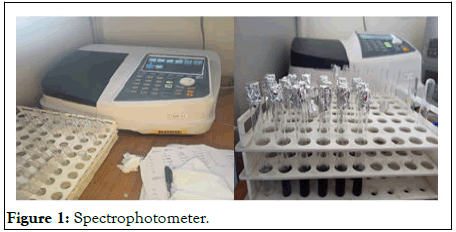
Figure 1: Spectrophotometer.
Radical scavenging testing, DPPH method
Radical scavenging testing, DPPH method is based on the evaluation of the reducing ability of antioxidants toward DPPH, which is stable nitrogen radical, possessing an odd electron. The color of its solution fades rapidly when it encounters radical scavengers. In this case, steric accessibility is a major determinant of the analytical reaction. The most useful antioxidants scavenging DPPH are gallic acid, tannic acid, ascorbic acid, and quercetin.
In this experiment, ascorbic acid standards were used.
3.94 mg DPPH got dissolved in 100 ml methanol and 0.05 gm ascorbic acid with 50 ml methanol. Then following protocol was followed:
3 ml sample extract added with 1 ml DPPH and mixing got done on vortex at room temperature for 5 minutes then took readings at 517 nm.
Triplicates were made for each sample extract.
The antimicrobial activity
Antimicrobial activity was determined by plating bacterial and fungal strains and applying different extracts to calculate the zone of inhibition (Figure 2).
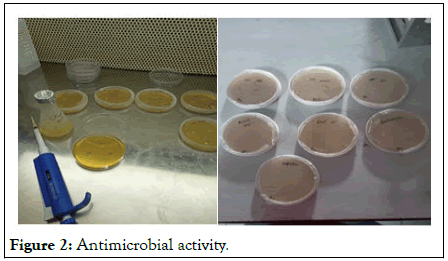
Figure 2: Antimicrobial activity.
Bacteria, yeast, ampicillin, and penicillin’s inhibition zones were checked to determine microbial activities: For bacteria nutrient agar broth were used, well were bored and filled with 10 micro ml sample along with ampicillin and penicillin, all procedure was done in laminar airflow then after incubation for 24 hrs antimicrobial activities were checked by measuring inhibition zones.
For yeast YPD media were used, well were bored and filled with 10 micro ml sample along with ampicillin and penciling, all process was done in laminar airflow then after incubation for 72 hrs inhibition zones were checked.
Gallic acid standards
Total phenolic content presence: Tpc was expressed as mg of Gallic Acid Equivalent (GAE). Maximum presence of phenolic acid content found in wheat flour while wheat bread had more phenolic content comparative to wheat roti (Figure 3 and Table 1).
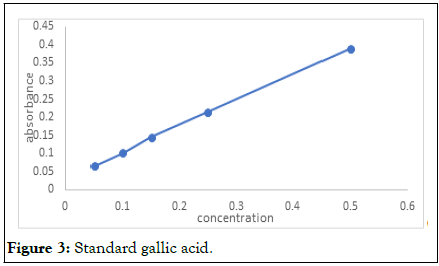
Figure 3: Standard gallic acid.
| X-axis | Y-axis |
|---|---|
| 0.05 | 0.065 |
| 0.1 | 0.101 |
| 0.15 | 0.145 |
| 0.25 | 0.215 |
| 0.5 | 0.39 |
Table 1: Gallic acid standards.
A substantial reduction was observed in TPC as per the polarity of solvent i.e. phenolic acid was most active in double-distilled water and released in hexane for each sample.
Maximum phenolic content in wheat flour could be attributed to the presence of bran in it as bran contains maximum phenolic acids. For producing different varieties of food items loss of phenolic acid occurred like in bread and roti could also be the result of excessive heating, baking, and various mechanical and chemical method applications.
The TPC for wheat flour was 0.5 mg/GAE/g while for roti it has been reported as 0.059 mg/GAE/g (Figures 4-6).
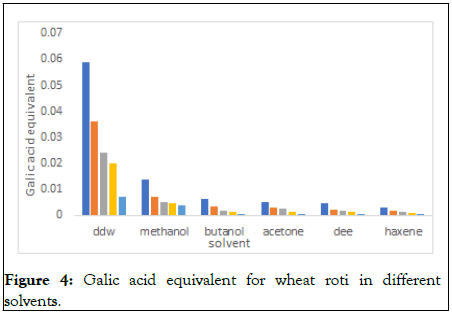
Figure 4: Galic acid equivalent for wheat roti in different solvents.
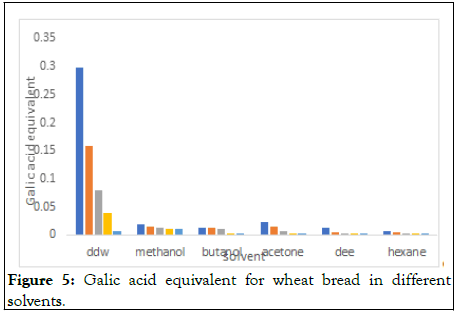
Figure 5: Galic acid equivalent for wheat bread in different solvents.
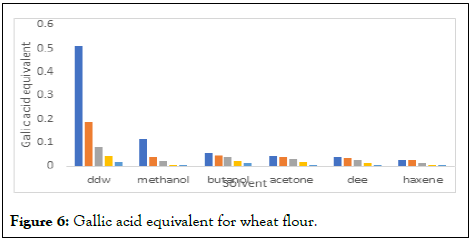
Figure 6: Gallic acid equivalent for wheat flour.
Rutin standards and flavonoids
Food processing including mixing kneading heating affects the antioxidant properties of food Chlopicka, et al., reported that the TFC of wheat roti was higher than that of wheat flour. In the present study, the TFC of wheat flour and wheat roti showed a measurable difference compared to wheat bread (Table 2). The presence of different antioxidants can be different in the different processing stage for same food item (Figures 7-11).
| X-axis (conc.) | Y-axis (absorbance at 415 nm) |
|---|---|
| 0 | 0.2 |
| 0.1 | 0.3 |
| 0.2 | 0.4 |
| 0.3 | 0.5 |
| 0.4 | 0.6 |
| 0.5 | 0.7 |
Table 2: Rutin standards and flavonoids.
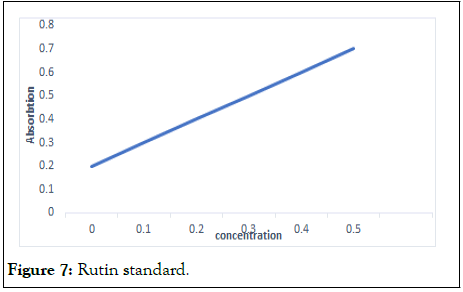
Figure 7: Rutin standard.
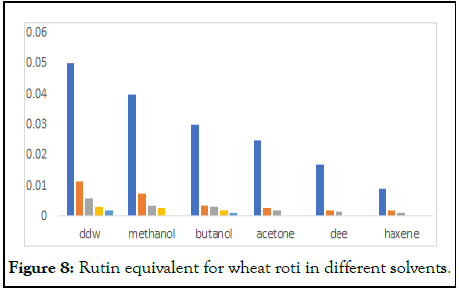
Figure 8: Rutin equivalent for wheat roti in different solvents.
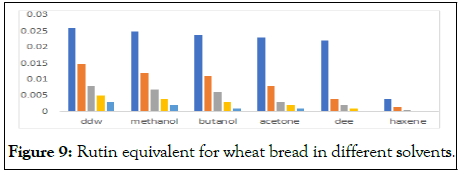
Figure 9: Rutin equivalent for wheat bread in different solvents.
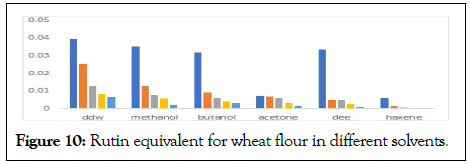
Figure 10: Rutin equivalent for wheat flour in different solvents.
DPPH Radical scavenging activity assay DPPH, radical scavenging activity decreased during the bread and roti-making process (Table 3) [3].
| DDW | Methanol | Butanol | Acetone | Diethyl ether | Hexane | |
|---|---|---|---|---|---|---|
| Flour | 2.53 | 0.69 | 0.61 | 0.691 | 0.611 | 0.536 |
| Bread | 2.18 | 0.61 | 0.596 | 0.432 | 0.337 | 0.245 |
| Roti | 2.03 | 0.591 | 0.488 | 0.246 | 0.147 | 0.11 |
Table 3: Radical scavenging activity assay.
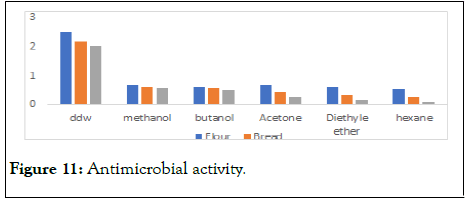
Figure 11: Antimicrobial activity.
The antimicrobial activity
The antimicrobial activity has been determined by plating bacterial and fungal strains and applying different concentrations of all the extracts to calculate the zone of inhibition. All samples exhibit antimicrobial activity at different extents. Samples with methanol show the maximum antimicrobial activities which could be analyzed by larger inhibitory zones in both of the cases of bacteria and yeast. While with water smallest inhibitory zones were obtained. Here we can conclude that water or moisture can spoil wheat and wheat products. The antimicrobial activity was in the order of wheat flour>roti>bread.
Overheating, refining and processing degrade the presence of antioxidants. The results showed that there was a substantial reduction in the antioxidant property of chapatti samples as compared to wheat flour extracts for TPC. Total flavonoids also have less presence in the processed stage of wheat form. The antioxidant potential and antimicrobial activity of wheat flour are more than that of wheat bread and roti. Wheat flour contains maximum wheat bran which has high antioxidants and is highly antimicrobial in nature. Hence the involvement of optimum amount of bran can increase the benefits and lifespan of wheat food products.
[Crossref] [Google Scholar] [PubMed]
[Crossref] [Google Scholar] [PubMed]
[Crossref] [Google Scholar] [PubMed]
[Crossref] [Google Scholar] [PubMed]
[Crossref] [Google Scholar] [PubMed]
[Crossref] [Google Scholar] [PubMed]
[Crossref] [Google Scholar] [PubMed]
[Crossref] [Google Scholar] [PubMed]
Citation: Chaudhary N, Gupta G (2023) Analysis and Comparative Presence of Antioxidants in Different Food Forms of Wheat. Nutr Food Sci. 13:019.
Received: 29-Dec-2022, Manuscript No. JNFS-22-21205; Editor assigned: 02-Jan-2023, Pre QC No. JNFS-22-21205 (PQ); Reviewed: 16-Jan-2023, QC No. JNFS-22-21205; Revised: 27-Mar-2023, Manuscript No. JNFS-22-21205 (R); Published: 03-Apr-2023 , DOI: 10.35248/2155-9600.23.13.019
Copyright: © 2023 Chaudhary N, et al. This is an open-access article distributed under the terms of the Creative Commons Attribution License, which permits unrestricted use, distribution, and reproduction in any medium, provided the original author and source are credited.